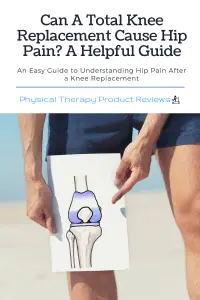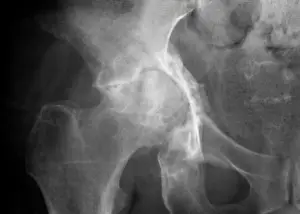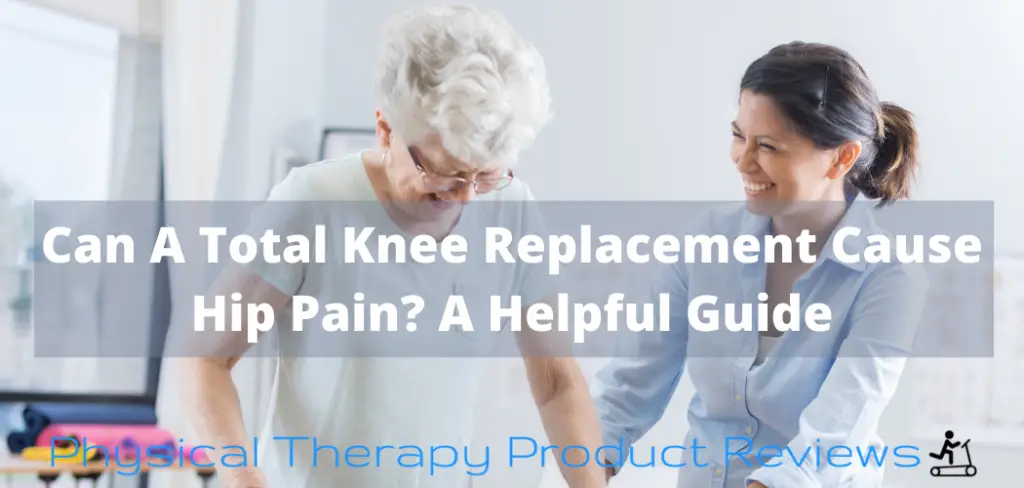Can a total knee replacement cause hip pain? It is not uncommon for patients to experience pain in both joints at the same time. In fact, there are many reasons why your hip might be more painful after a total knee replacement. There is a lot of additional stress placed on the body after surgery and the hip might be ready for the extra stress.
 It could also be due to an underlying condition that may have been present even before they had their surgery. The good news is that there are ways of helping relieve these symptoms and reduce the risk of developing long-term problems with your hips.
It could also be due to an underlying condition that may have been present even before they had their surgery. The good news is that there are ways of helping relieve these symptoms and reduce the risk of developing long-term problems with your hips.
We’ll help you learn why your hip might be hurting after a knee replacement, how long it will last, and what you can do about it now without aggravating your new knee replacement.
Why Does Your Hip Hurt After a Knee Replacement
After a knee replacement, everything gets a new onset of stress and out-of-whack. You start to walk differently to protect the knee that was just operated on, you’ll sleeping differently, and stand differently after a knee replacement until it begins to fully heal. This typically takes 8-12 weeks but can take up to a full year to fully feel normal.
There was Likely Already Arthritis in That Hip Before the Knee Replacement
If you have an underlying condition such as arthritis in the painful hip before surgery, then there is a good chance it might hurt more after a knee replacement.
If you’ve already had a knee replacement then you are no stranger to arthritis and there is likely some in the hips too.

This makes the hip’s ability to take on extra load and responsibility low. After knee surgery, the body is looking to compensate in any way it can to help out the new surgical knee and the hip is the first place to take up the extra compensation.
Gait Pattern Changes
The hip on the non-surgical side now has 100% of the weight through it with walking. You’ll be leaning on the walker, crutches, or cane on the surgical side and placing way more stress on the non-surgical hip. There is also pain, tightness, and swelling to contend with. Changes in gait after a knee replacement can last up to 15 months after surgery in some cases!

Weight-Bearing Changes
When you think about your weight distribution, the more weight is on one side of a person’s body, the higher chance there will be for hip pain. The total knee replacement shifts all this weight and posture change onto that non-surgical side placing much more stress through that joint.
That increased stress takes place anytime you are standing or doing an activity as the knee replacement takes time to heal.
Positional Changes and Pressure
You’ll also be putting more pressure on the hips to avoid putting pressure on the knee in sitting, lying down, and in the car. You’ll find yourself twisting to find a comfortable position which may be at the sacrifice of the hip. What how you are sitting or lying to make both the hips and knees happy.
How Long will Your Hip Hurt After a Knee Replacement?
Typically the faster that your knee starts to feel better the sooner that your hip will also feel better. Each person has a different timeline because people’s hip arthritis, obesity levels, and other health factors are all different.
In general, the hip should start to feel quite a bit better 4-6 weeks after normal walking mechanics have been established from the knee replacement.
Tips for a Normal Gait After Knee Replacement
After surgery, you’re walking and gait will be quite a bit different than before surgery. As there is considerable pain after surgery, you’ll be limping with each step, probably using an assistive device such as a walker, and compensating with the other leg.
The sooner you can get back to a normal walking pattern the sooner your back, hip, or other joints will be painful.
Use a Walker Until You Can Walk Without a Limp
You’ll need to use a walker or crutches for at least the first two weeks after surgery. This is because your knee needs time to heal and you should not take any weight through it until this time.
The goal of using these devices is to avoid placing too much pressure on that new, operated-on leg by leaning on it or walking on the operated-side leg. This will help avoid an early hip injury as well.
A study from Johns Hopkins Medicine found that people who used a cane were more likely to experience hip pain than those with crutches or just using the walker for balance and stability.
Focus on Getting Knee Extension With Walking
Your knee replacement surgery will make it difficult for your muscles to provide the extension that is needed when walking. This means you won’t be able to take full steps, but this should start getting better in about six weeks, and by four months post-surgery, you can expect near-normal function.
In order to get as close as possible back to walking as you did before surgery, focus on straightening your leg up and down. This will help to activate the muscles that are needed for knee extension.
Don't Let Your Trunk Lean
One of the most common compensations with walking after a total knee replacement is to use the trunk to lean. The lean typically happens with a trunk lean in two different directions; forward and to the same side as the surgical leg.
Both of these trunk leans are to help take weight and pressure off of the knee replacement.
To fix these try walking in front of a mirror to watch your trunk. Try and keep upright and the shoulders facing forward.
You can also help train yourself by walking backward. This takes the pressure off of the knee and trains the body back into a normal walking pattern.
Try and Push Off with the Surgical Leg
The body wants to get off of the surgical knee as quickly as it possibly can. This means that the leg never gets into the push-off phase in gait. Without that push-ff, it puts pressure on the hip and low back.

To fix this, try to push off with the big toe on the surgical site. This helps the leg get into extension before it progresses forward.
Another drill we like for this is a high knee marching to help weight bear and push off the legs in a full extension.
3 Tips for Walking Normal After a Knee Replacement
Exercises to Help You Hip After a Knee Replacement
Supine Glute Stretch
While lying on your back, bend and cross one leg across your body to the opposite side. Grab the leg with your hand and pull it down towards the floor and try to hold it for 30 seconds or longer.
Video: https://www.youtube.com/watch?v=ZechiSAs-kA
Glute Bridge
Start with your back straight, feet flat on the ground, and hands at your side or under your glutes to help you push up into a bridge position. Place one hand over the other in order to increase the intensity of this exercise if desired. Bridge up with your hips and feet in a “V” position. Tighten the glutes muscles to hold this bridge for 15-30 seconds before you release back down.
Video: https://www.youtube.com/watch?v=SwyDMwpcW38
Side-Lying Clamshells
Lying on your side, with your hips and knees bent, place a resistance band around both of your knees. Slowly lift your top knee towards the ceiling putting tension on the resistance band. Go as high as you can and then return back to the starting position.
Other Ways to Address Hip Pain After Knee Surgery
Beyond taking care of your total knee replacement there are few other things that you can do to help with the hip pain.
Use Heat on the Hip for Pain Control
Heat can help relieve pain by increasing blood flow and relaxing muscles. You can buy a heating pad to use on your hip or microwave rice in a bowl for heat therapy that is soothing and comfortable.
Stretch the Hip Muscles
The key with stretching is to focus on what feels good not just going through the motions because it will take some time before your hip feels better.
Consider A Hip Brace or Belt
A hip brace can help with the pain associated with movement and activity while a belt will offer compression as well to provide relief from pain. Either one of these can be helpful if you are self-conscious about not being able to wear tight clothes due to surgery or just need some extra
Use a Massage Gun
The massager is a good way to relax your muscles and release tension from the area. You can use it in a search and destroy method to find the sore muscles and areas of the hip. It’s also easy to use on yourself without having to have a partner help.
We love the massage guns because they are easy to use, have multiple different settings, and can be quite effective on those tight muscles.
Conclusion
The purpose of this article is to review if a total knee replacement can cause hip pain. The intent was to provide an overview as well as how long it might take for the person’s hip joint and muscles around that area to heal, what exercises they can do in order to help with their hips after surgery, and other ways of managing the pain.
It is true that a total knee replacement can cause hip pain, however, the person may not experience any discomfort until after their surgery when they are required to use their hips and muscles in new ways than before the surgery.
Other Great Rehab Related Articles
How to Stay Active After Cervical Fractures: Expert Tips and Advice
Dealing with Painful Stairs After Ankle Replacement Surgery
Walking After a Total Ankle Replacement: Tips for a Successful Recovery
Exercises While Non-Weight Bearing After Ankle Replacement: Elevation, AROM, Leg Raises, and More
Ankle Pain with Stairs: Causes and Home Treatment Options
5 Common Mistakes You’re Making After an Ankle Sprain
Disclaimer: The information provided in this post is for educational purposes only. This is not a substitute for a medical appointment. Please refer to your physician before starting any exercise program.










